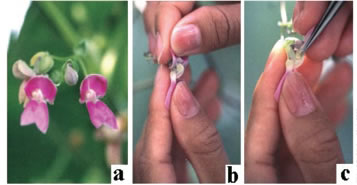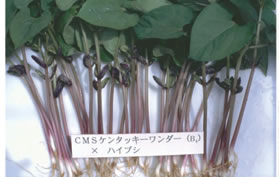Development of male-sterile lines of snap bean (Phaseolus vulgaris) varieties using male-sterile cytoplasm detected from a cultivar ‘Kurodane Kinugasa’
Description
[Objectives]
To increase the diversity of snap bean varieties cultivated in tropical and subtropical areas, we are attempting to incorporate high yielding ability under high temperatures exhibited by'Haibushi'into other cultivars through conventional crossbreeding methods. During the course of crossing procedures, we found that a cultivar 'Kurodane Kinugasa' produced semi-sterile hybrids when crossed as a female parent with'Haibushi'. Since the reciprocal cross, 'Haibushi' × 'Kurodane Kinugasa' exhibited a high pollen stainability, the occurrence of male sterility in this cross combination is concluded to be cytoplasmic. We attempted to develop male sterile lines of snap bean varieties using this cytoplasm.
[Results]
By backcrossing in which 'Kurodane Kinugasa' was involved as a non-recurrent female parent and other varieties as recurrent male parents, we developed cytoplasmic male sterile (CMS) lines of the following varieties to date; 'Haibushi'(B11), 'Kentucky Wonder'(B8), 'Sabel'(B8), 'Ishigaki No. 2'(B8), 'Golden Wax'(B8), 'Kurosando'(B8), 'Kamogawa Green'(B8), 'Nerina'(B8), 'Ichizu'(B6), 'Sayakazari'(B6), 'Supander'(B6). The number of the backcrossing generation is shown in the form of Bn in parentheses. By using these CMS lines as female parents for the crossing, we can easily produce hybrids without castration as illustrated in Fig. 1.
The color of hypocotyls of some CMS lines is green, while that of others is purple. Purple coloration is a dominant character as compared to green color. Based on the coloration of the hypocotyl, hybridity of the seeds obtained by pollinating the CMS lines with green hypocotyl (e.g. 'Kentucky Wonder') with purple varieties (e.g. 'Haibushi') were examined. The plants obtained from such cross-combinations had purple hypocotyl and were judged to be hybrids (Fig. 2). These CMS lines are thus very useful for producing hybrids efficiently and successfully, and are considered to be useful for studying genetic segregation patterns of morphological and physiological characteristics of snap bean.
Figure, table
-
Fig. 1. Cross-pollination using cytoplasmic male sterile (CMS) lines. (a) Flowers that opened on the day of flowering. (b) Stigma can be easily extended from the open mouth of keel petal by pressing down the wing petals with fingers. (c) Then, the stigma was pollinated with fertile pollen. -
Fig. 2. Hypocotyls of the plants derived from CMS ‘Kentucky Wonder’ (green) × ‘Haibushi’ (purple) showed purple color, verifying the hybrid nature of the plants.
- Affiliation
-
Japan International Research Center for Agricultural Sciences Okinawa Subtropical Station
-
Bio-oriented Technology Research Advancement Institution
- Classification
-
Technical A
- Term of research
-
FY2001 (FY1998-2005)
- Responsible researcher
-
EGAWA Yoshinobu ( Okinawa Subtropical Station )
TSUKAGUCHI Tadashi ( Bio-oriented Technology Research Advancement Institution )
SUZUKI Katsumi ( Okinawa Subtropical Station )
SHONO Mariko ( Okinawa Subtropical Station )
- ほか
- Publication, etc.
-
Y. Egawa, T. Tsukaguchi and K. Suzuki. (2002): Development of male-sterile lines of snap bean (Phaseolus vulgaris) varieties using male-sterile cytoplasm detected from 'Kurodane Kinugasa'. Japanese Journal of Tropical Agriculture, 46 (Extra issue 1), 61-62. (in Japanese)
- Japanese PDF
-
2001_21_A3_ja.pdf947.87 KB
- English PDF
-
2001_18_A4_en.pdf116.22 KB


